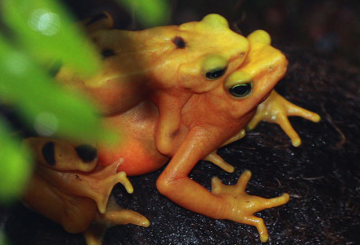TOP STORIES Scientists can't explain cause of amphibian extinction crisis
Scientists can't explain cause of amphibian extinction crisis
Mongabay - news.mongabay.com
13 Nov 2008
Image courtesy of Rhett A. Butler
Scientists have yet to conclusively explain the underlying cause of global declines in amphibian populations, according to a study published in the journal Proceedings of the National Academy of Sciences. The research says that two leading theories for the demise of amphibians — both related to the emergence and spread of the deadly chytrid fungus — are not supported by scientific data. The researchers don't dispute that chytrid is killing amphibians but they say that data does not support either the chytrid-thermal-optimum hypothesis — which holds that climate change has created conditions optimal for the growth of the chytrid fungus — or the spatiotemporal-spread hypothesis — which describes the spread of chytrid from certain locations.
>>>Evaluating the links between climate, disease spread, and amphibian declines. Proc Natl Acad Sci U S A. 2008 Nov 5. [Epub ahead of print]
Beached sea lions herald potential new leptospirosis outbreak
Westerly News - /www.canada.com/westerly
13 Nov 2008
T Mureika
Area: Vancouver Island, British Columbia, Canada - Map It

A sick sea lion was found washed ashore on Mary Kimoto's property at the entrance to Ucluelet Harbour, while a dead sea lion was found beached this past Sunday. A new leptospirosis outbreak has been reported in the northwestern United States, primarily affecting California sea lions, says Pete Clarkson from Parks Canada. He says this is a cyclical event that occurs fairly regularly and it's possible these two beached mammals may be tied to a recurrence of the disease. But without proper tissue samples, Clarkson says this prognosis remains speculative.
 Colonies in collapse: What's causing massive honeybee die-offs? Part 1
Colonies in collapse: What's causing massive honeybee die-offs? Part 1Penn State University - live.psu.edu
11 Nov 2008
M Beattie-Moss
Image courtesy of Paul D. Cocker
. . . By all accounts, the varroa mite — maroonish brown and about the size of a sesame seed — is primarily responsible for the mounting losses in the North American beekeeping industry over the last two decades, including catastrophic die-offs in American bees during the winters of 1995-6 and 2000-01. A 2005 study led by Penn State entomologist Diana Cox-Foster found that once the mites take hold in a hive, they suppress bee immunity. “Varroa mites in a colony open the door for many viruses and bacteria,” says Cox-Foster, noting that the pest is “widespread across the United States.” While the pesticides approved for use against varroa mites initially kept infestations in check, within several years mites in many parts of the country had begun to develop resistance to the chemicals.
First Holistic Guide to Primate Disease Covers Critical Gap in Global Health
Media Newswire - media-newswire.com
12 Nov 2008
Why are so many infectious diseases jumping from animals to humans? Why do we have so little capacity to predict epidemics, or avoid them? Some answers, and possible solutions, can be found in the first trench-to-bench guide to wild primate infectious diseases, to be published Nov. 17 in the Yearbook of Physical Anthropology. "There is growing awareness that the majority of emerging pathogens in the world are coming from wildlife. And most of that wildlife is in tropical forests – in places where we have the least disease surveillance," says Thomas Gillespie, assistant professor of environmental studies at Emory University, and lead author of the article.
 National HPAI Early Detection Data System (HEDDS) Update
National HPAI Early Detection Data System (HEDDS) UpdateNBII Wildlife Disease Information Node
13 Nov 2008
Area: United States
The presumptive test results for samples collected on Oct 19, 2008 from a American Green-winged teal in Carroll county are positive for low pathogenic avian influenza. For additional information visit HEDDS' LPAI H5N1 Results Table. For more avian influenza news from HEDDS.
OTHER WILDLIFE HEALTH RELATED NEWS
Image courtesy of Simon Goodman, University of Leeds/Caspian International Seal Survey
 Pictured: Caspian seal numbers plummet 90%
Pictured: Caspian seal numbers plummet 90%- Why Won't Jersey Dolphins Go to Sea?
- Rare Salamander Dies at National Zoo
- Chinese menus, medicine threatening wildlife
- Yes, we have no brucellosis [Wyoming]
- DEC Warns Against Feeding Waterfowl after Finding Dead & Dying Geese [Aspergillosis] - Clinton County, New York, USA - Map It

- Bird flu detected in Thailand's Uthai Thani province





No comments:
Post a Comment